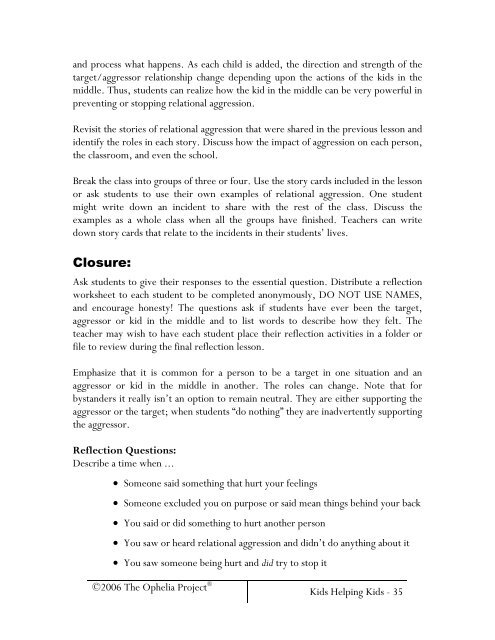Kids Helping Kids
KidsHelpingKids
KidsHelpingKids
- No tags were found...
Create successful ePaper yourself
Turn your PDF publications into a flip-book with our unique Google optimized e-Paper software.
and process what happens. As each child is added, the direction and strength of the<br />
target/aggressor relationship change depending upon the actions of the kids in the<br />
middle. Thus, students can realize how the kid in the middle can be very powerful in<br />
preventing or stopping relational aggression.<br />
Revisit the stories of relational aggression that were shared in the previous lesson and<br />
identify the roles in each story. Discuss how the impact of aggression on each person,<br />
the classroom, and even the school.<br />
Break the class into groups of three or four. Use the story cards included in the lesson<br />
or ask students to use their own examples of relational aggression. One student<br />
might write down an incident to share with the rest of the class. Discuss the<br />
examples as a whole class when all the groups have finished. Teachers can write<br />
down story cards that relate to the incidents in their students’ lives.<br />
Closure:<br />
Ask students to give their responses to the essential question. Distribute a reflection<br />
worksheet to each student to be completed anonymously, DO NOT USE NAMES,<br />
and encourage honesty! The questions ask if students have ever been the target,<br />
aggressor or kid in the middle and to list words to describe how they felt. The<br />
teacher may wish to have each student place their reflection activities in a folder or<br />
file to review during the final reflection lesson.<br />
Emphasize that it is common for a person to be a target in one situation and an<br />
aggressor or kid in the middle in another. The roles can change. Note that for<br />
bystanders it really isn’t an option to remain neutral. They are either supporting the<br />
aggressor or the target; when students “do nothing” they are inadvertently supporting<br />
the aggressor.<br />
Reflection Questions:<br />
Describe a time when ...<br />
• Someone said something that hurt your feelings<br />
• Someone excluded you on purpose or said mean things behind your back<br />
• You said or did something to hurt another person<br />
• You saw or heard relational aggression and didn’t do anything about it<br />
• You saw someone being hurt and did try to stop it<br />
©2006 The Ophelia Project ®<br />
<strong>Kids</strong> <strong>Helping</strong> <strong>Kids</strong> - 35


